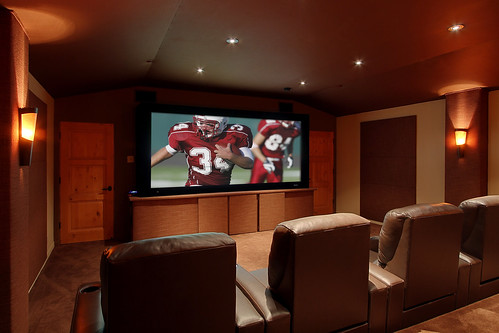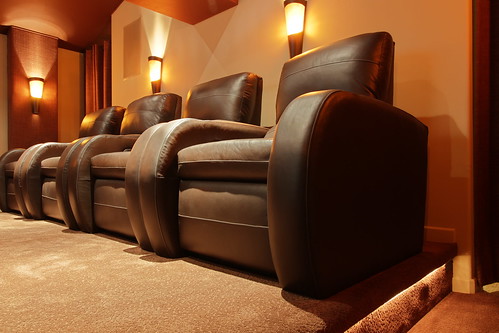 Home theaters are quickly replacing the family room as the location in the home where everyone gathers. There are numerous things that go into the design and construction of a home theater room. It is not as simple as picking a few ingredients and having an installer assemble them.
Home theaters are quickly replacing the family room as the location in the home where everyone gathers. There are numerous things that go into the design and construction of a home theater room. It is not as simple as picking a few ingredients and having an installer assemble them.
- What are the good brands to consider?
- What kind of costs can I expect?
- How big a screen can I use in the room?
- What is the optimum distance to the screen and where is the best seating position?
- What products will yield the best sound in the space?
- Should I use one subwoofer or more, and where should they be placed?
As you can see, even some of the basic choices arent really so basic. Lets break down what you need to consider and why.
The Room
The first place to start is the room you intend to house the home theater in. The size of the room will determine the size and type of video display device (plasma TV, LCD TV, LED TV, rear or front projector) that would be best to use. Additional room items to consider are:
- How much ambient light is present?
- What type of wall construction do you have (drywall, glass, etc.)?
- Will you be placing your home theater system components in a cabinet or closet?
- Will you be installing your speakers in the wall or ceiling?
 The Video Display
The Video Display
This is the first component to consider, as it is the core of every home theater. After all, the idea of home theater is to bring the giant movie theater experience home, and generally, nothing does a more realistic job of that than a good front projection TV. The other options mentioned earlier (i.e. LCD, plasma) will also do well, but there are very few choices available above a 70 inch screen size in these types of televisions. Additionally, factors such as room light, control, seating position and viewing angle all play a role in the type and size of display.
Audio System
The most essential element of the movie theater experience is sound. The way sound is implemented in a home theater system is critical to the overall experience and possibly even more so than the picture. The impact and excitement of a movie or sporting event is delivered through the audio system! When choosing the audio system, there are several different components you need to consider. Lets start with the electronics.
Receivers
The A/V (audio video) receiver is the basis of the audio system. It provides the amplification and the features that will drive the sound. Receivers are made up of three components; a) an amplifier for powering the loudspeakers, b) a preamplifier for processing the sound, and c) a tuner for picking up radio stations (optional). A/V receivers or separate components need to be matched to the room and the speakers in order to optimize audio performance. Surround sound processors have the ability to make the room larger or smaller. Your mind knows when you are in a small jazz club or when you are in a large concert hall, and the processing capability of your electronics delays sounds to each speaker in order to recreate these kinds of environments in your room.
Loudspeakers
The next components to consider for your home theater system are the loudspeakers. You will need at least five to seven speakers. The center channel speaker placed above, below or even behind the screen will deliver the dialogue/voices. The left and right front speakers will be placed on either side and will create the width of the scene on the screen, and the left and right rear speakers will create the depth of the environment. When utilizing seven speakers, two more speakers are placed on the side walls. The last speaker(s) you will need is called the subwoofer. Its job is to recreate the deep bass sounds that deliver impact and help you feel the home theater experience. In many systems you can get away with one subwoofer, but THX recommends four.
Source Components
It is important to consider that your picture and sound will only be as good as the signal or information you give to them. HDTV will require a satellite or cable service provider. Additionally, you can obtain a DVR (Digital Video Recorder) for recording your favorite shows. Other source components include a media player for streaming internet content, Blu-Ray player, CD player, HD Radio and even a turntable.
Control Systems
Each component in a home theater system comes with its own remote, leading to a collection that can number half a dozen or more. One solution is to opt for a sophisticated but easy-to-use universal remote that can control most of the functions of each of your components. Control systems can also be programmed to control lighting, heating and air conditioning, and so much more.
 Seating
Seating
You have a fancy home theater system; now you need some comfortable furniture that will make you want to spend your time with your home theater. Your furniture can be of the traditional sofa and chair variety, or you can opt for specialized home theater furniture that includes features such as built-in cup holders, extra-overstuffed padding and motorized recliners.
Room Treatments
These are panels or objects that compensate for the amount of glass, floors, wood and other materials used in the room construction. These will all have an effect on the video, sound and control of the experience. You dont want the room to be too live or too dead.
Final Take
There are a myriad of things to consider when planning your home theater and your budget. Remember: Your goal is to do it right, so you may want to consider what aspects of the room and system are most important to you in order to maximize the result.
